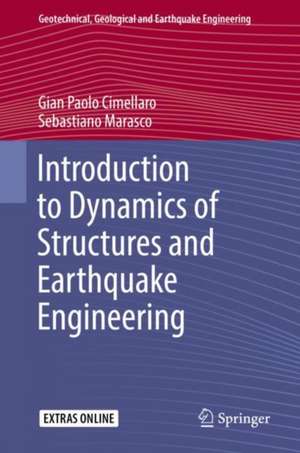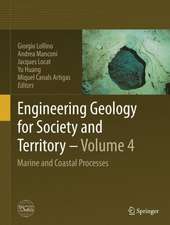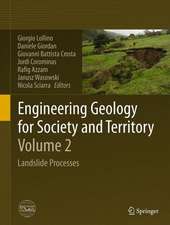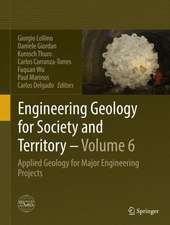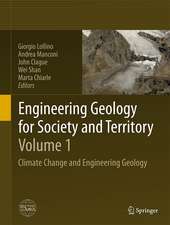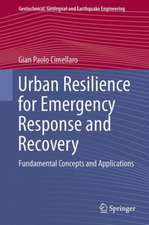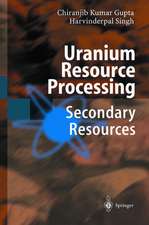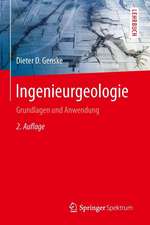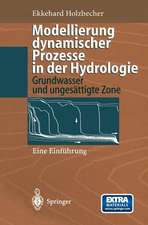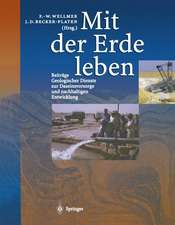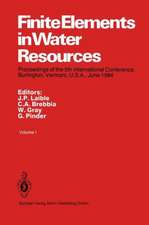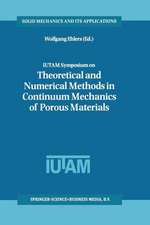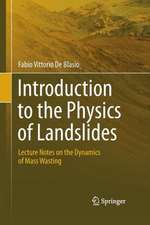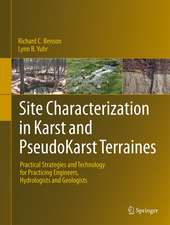Introduction to Dynamics of Structures and Earthquake Engineering: Geotechnical, Geological and Earthquake Engineering, cartea 45
Autor Gian Paolo Cimellaro, Sebastiano Marascoen Limba Engleză Hardback – 10 apr 2018
This work is an elementary but comprehensive textbook which provides the latest updates in the fields of Earthquake Engineering, Dynamics of Structures, Seismology and Seismic Design, introducing relevant new topics to the fields such as the Neodeterministic method. Its main purpose is to illustrate the application of energy methods and the analysis in the frequency domain with the corresponding visualization in the Gauss-Argant plan. However, emphasis is also given to the applications of numerical methods for the solution of the equation of motion and to the ground motion selection to be used in time history analysis of structures. As supplementary materials, this book provides “OPENSIGNAL", a rare and unique software for ground motion selection and processing that can be used by professionals to select the correct earthquake records that would run in the nonlinear analysis.
The book contains clear illustrations and figures to describe the subjectin an intuitive way. It uses simple language and terminology and the math is limited only to cases where it is essential to understand the physical meaning of the system.
Therefore, it is suitable also for those readers who approach these subjects for the first time and who only have a basic understanding of mathematics (linear algebra) and static analysis of structures.
| Toate formatele și edițiile | Preț | Express |
|---|---|---|
| Paperback (1) | 590.09 lei 38-44 zile | |
| Springer International Publishing – 25 dec 2018 | 590.09 lei 38-44 zile | |
| Hardback (1) | 601.22 lei 38-44 zile | |
| Springer International Publishing – 10 apr 2018 | 601.22 lei 38-44 zile |
Din seria Geotechnical, Geological and Earthquake Engineering
- 15%
 Preț: 665.73 lei
Preț: 665.73 lei - 18%
 Preț: 1405.90 lei
Preț: 1405.90 lei - 15%
 Preț: 717.59 lei
Preț: 717.59 lei - 18%
 Preț: 959.19 lei
Preț: 959.19 lei - 15%
 Preț: 656.43 lei
Preț: 656.43 lei - 18%
 Preț: 1944.11 lei
Preț: 1944.11 lei -
 Preț: 392.60 lei
Preț: 392.60 lei - 18%
 Preț: 954.62 lei
Preț: 954.62 lei - 18%
 Preț: 954.45 lei
Preț: 954.45 lei - 15%
 Preț: 638.24 lei
Preț: 638.24 lei - 18%
 Preț: 954.45 lei
Preț: 954.45 lei - 15%
 Preț: 640.24 lei
Preț: 640.24 lei - 20%
 Preț: 572.65 lei
Preț: 572.65 lei - 24%
 Preț: 805.40 lei
Preț: 805.40 lei - 20%
 Preț: 602.78 lei
Preț: 602.78 lei - 15%
 Preț: 639.08 lei
Preț: 639.08 lei - 18%
 Preț: 1242.83 lei
Preț: 1242.83 lei - 15%
 Preț: 639.73 lei
Preț: 639.73 lei - 15%
 Preț: 637.46 lei
Preț: 637.46 lei - 18%
 Preț: 1222.01 lei
Preț: 1222.01 lei - 18%
 Preț: 967.08 lei
Preț: 967.08 lei - 18%
 Preț: 959.98 lei
Preț: 959.98 lei - 15%
 Preț: 658.88 lei
Preț: 658.88 lei - 18%
 Preț: 969.44 lei
Preț: 969.44 lei - 15%
 Preț: 653.79 lei
Preț: 653.79 lei - 15%
 Preț: 657.73 lei
Preț: 657.73 lei - 18%
 Preț: 961.55 lei
Preț: 961.55 lei - 15%
 Preț: 652.49 lei
Preț: 652.49 lei - 18%
 Preț: 961.86 lei
Preț: 961.86 lei - 15%
 Preț: 649.06 lei
Preț: 649.06 lei -
 Preț: 450.02 lei
Preț: 450.02 lei - 18%
 Preț: 967.22 lei
Preț: 967.22 lei - 18%
 Preț: 1117.99 lei
Preț: 1117.99 lei - 15%
 Preț: 656.58 lei
Preț: 656.58 lei
Preț: 601.22 lei
Preț vechi: 742.25 lei
-19% Nou
Puncte Express: 902
Preț estimativ în valută:
115.06€ • 124.94$ • 96.65£
115.06€ • 124.94$ • 96.65£
Carte tipărită la comandă
Livrare economică 18-24 aprilie
Preluare comenzi: 021 569.72.76
Specificații
ISBN-13: 9783319725406
ISBN-10: 3319725408
Pagini: 598
Ilustrații: XXIII, 598 p. 552 illus., 191 illus. in color. With online files/update.
Dimensiuni: 155 x 235 x 34 mm
Greutate: 1.18 kg
Ediția:1st ed. 2018
Editura: Springer International Publishing
Colecția Springer
Seria Geotechnical, Geological and Earthquake Engineering
Locul publicării:Cham, Switzerland
ISBN-10: 3319725408
Pagini: 598
Ilustrații: XXIII, 598 p. 552 illus., 191 illus. in color. With online files/update.
Dimensiuni: 155 x 235 x 34 mm
Greutate: 1.18 kg
Ediția:1st ed. 2018
Editura: Springer International Publishing
Colecția Springer
Seria Geotechnical, Geological and Earthquake Engineering
Locul publicării:Cham, Switzerland
Cuprins
1. Part I Dynamics of Structures. Introduction.- 2. SDOF Systems.- 3. Methods of Solution of the Equation of Motion.- 4. MDOF Systems.- 5. Energy Dissipation.- 6. Damping on Structures.- 7. Distributed Mass and Elasticity Systems.- 8. Generalized SDOF Systems.- 9. Part II Introduction to Earthquake Engineering. Seismology and Earthquakes.- 10. Major Seismic Events that Occurred in Italy and in the World.- 11. Seismic Hazard Analysis.- 12. Earthquake Prediction.- 13. Seismic Input.- 14. Opensignal.- 15. Methods of Analysis.- 16. Part III Seismic Design of Buildings. Brief Introduction to SAP2000.- 17. Modeling of Structures in Seismic Zone.- 18. Seismic Modelling of Infill Walls.- 19. Capacity Design.- 20. Passive Energy Dissipating Systems.- 21. Tuned-Mass Dampers.- 22. Base Isolation.- 23. Masonry Structures.- 24. Fundamentals of Probability and Statistics.- 25. Glossary.
Notă biografică
Gian Paolo Cimellaro is currently Associate Professor at the Politecnico di Torino. He has been recently Visiting Professor at the University of California Berkeley (2014-2016). He obtained his M.S. (2005) and Ph.D. (2008) from the University at Buffalo (SUNY) in USA. Graduated cum laude in Civil Engineering, University of Rome La Sapienza (2001). He is the Chair of the ASCE Committee on “Disaster Resilience of Structures, Infrastructures and Communities” in USA. In 2011, he has received the Fib Achievement Award for Young Engineers, sponsored by fib - the international federation for structural concrete. In 2015, he has received the Seed Grant Award from the Siebel Energy Institute of UC Berkeley. Prof. Cimellaro current research interests address earthquake engineering with emphasis to community resilience to natural disasters such as earthquakes. He has been awarded a grant of 1.3 M € by the European Research Council for the research project "IDEAL RESCUE: Integrated Design and control of sustainable communities During emergencies" ERC-2014-StG (2015-2019). This is the most prestigious prize assigned in Europe to researchers, performing high-risk and high-gain ground-breaking research.
Sebastiano Marasco is currently Ph.D. student at the Politecnico di Torino (Italy). He received his master degree in Civil Engineering from the Politecnico di Torino in 2014. His thesis focused on the signal processing of earthquake records and he has implemented a software called Opensignal for earthquake record processing and selection adopted in both practice and academic field. His expertise is in the advanced software programming, in the seismic design of reinforced concrete buildings and in the F.E.M. analysis. His research under the supervision of Professor Gian Paolo Cimellaro is focused on the assessment of resilience in a urban environment. This research is part of project IDEal reSCUE founded by the European Research Council. As a part ofthis research, he has collected the building’s data within a virtual city and developed an algorithm for estimating the capacity of each building under a seismic event.
Sebastiano Marasco is currently Ph.D. student at the Politecnico di Torino (Italy). He received his master degree in Civil Engineering from the Politecnico di Torino in 2014. His thesis focused on the signal processing of earthquake records and he has implemented a software called Opensignal for earthquake record processing and selection adopted in both practice and academic field. His expertise is in the advanced software programming, in the seismic design of reinforced concrete buildings and in the F.E.M. analysis. His research under the supervision of Professor Gian Paolo Cimellaro is focused on the assessment of resilience in a urban environment. This research is part of project IDEal reSCUE founded by the European Research Council. As a part ofthis research, he has collected the building’s data within a virtual city and developed an algorithm for estimating the capacity of each building under a seismic event.
Textul de pe ultima copertă
This work is an elementary but comprehensive textbook which provides the latest updates in the fields of Earthquake Engineering, Dynamics of Structures, Seismology and Seismic Design, introducing relevant new topics to the fields such as the Neodeterministic method. Its main purpose is to illustrate the application of energy methods and the analysis in the frequency domain with the corresponding visualization in the Gauss-Argant plan. However, emphasis is also given to the applications of numerical methods for the solution of the equation of motion and to the ground motion selection to be used in time history analysis of structures. As supplementary materials, this book provides “OPENSIGNAL", a rare and unique software for ground motion selection and processing that can be used by professionals to select the correct earthquake records that would run in the nonlinear analysis.
The book contains clear illustrations and figures to describe the subjectin an intuitive way. It uses simple language and terminology and the math is limited only to cases where it is essential to understand the physical meaning of the system.
Therefore, it is suitable also for those readers who approach these subjects for the first time and who only have a basic understanding of mathematics (linear algebra) and static analysis of structures.
Caracteristici
Provides a comprehensive and up-to-date overview of the fields of Earthquake Engineering, Dynamics of Structures, Seismology and Seismic Design Emphasizes the application of energy methods and the analysis in the frequency domain with corresponding visualization in the Gauss-Argant plan Illustrates the applications of numerical methods for the solution of the equation of motion and to the ground motion selection to be used in time history analysis of structures Provides unique software for ground motion selection and processing that can be used by professionals to select the correct earthquake records that would run in the nonlinear analysis Introduces new topics in the field such as the Neodeterministic method in simplified terms
